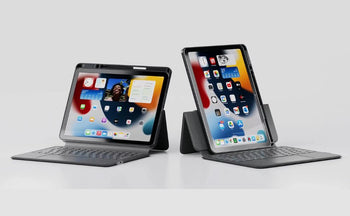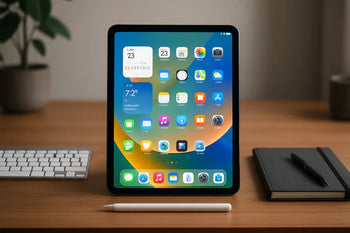Downloaded a file on an iPad, but it has disappeared? This is a common issue since iPads do not have a single, obvious Downloads folder, unlike computers.
Most files downloaded on an iPad are stored directly in the Files app, typically within the Downloads folder.
However, not every download ends up there. Photos often move to the Photos app, while music or videos may save to their own apps.
That can make it confusing to track down what was saved and where it went.
This guide explains the default download location, shows where different types of files are stored, and covers how to find items saved through apps like Mail or Messages.
It also provides tips to resolve missing downloads, ensuring nothing gets lost again.
Quick Insights 🔆:
- Files App → Downloads folder (default for Safari and most apps)
- Photos app (for images, videos, and media)
- Safari downloads manager (check recent downloads in browser)
- Third-party apps (Google Drive, Dropbox, etc. save files inside their app folders)
- Use the Search bar (Spotlight) if you can’t locate a file
❛❛Also Read: Forgot iPad Password? 4 Ways to Regain Access Fast❞
Where Do Downloaded Files Go on iPad
Most files that a person downloads on an iPad are stored in the Downloads folder within the Files app. This folder may appear under iCloud Drive or "On My iPad," depending on your settings.

To check, open the Files app, tap Browse, and look under Favorites for Downloads. If it is not listed, it can usually be found under one of the storage locations.
Not all downloads are directed to the same location. The location depends on the type of file and the app used to save it:
- Documents, PDFs, ZIP files, and videos usually go to the Files app > Downloads.
- Photos and screenshots saved from Safari or another app are automatically imported into the Photos app.
- Music or audio files may open in the Music app or a third-party audio app.
- Books or ePubs saved from Safari may open in the Apple Books app.
This design helps keep files organized. For example, saving a picture directly to the Photos app makes it easier to find later, while documents stay grouped in the Files app.
If someone cannot locate a file, it is best to check both the Files app and the Photos app first. These two locations cover most downloads on an iPad.
❛❛Also Read: How to Update iPad: A Guide for the Latest iPadOS Ipad❞
Default Location for Downloads on iPad
Most files downloaded on an iPad are saved automatically to a designated location. Apple uses the Files app as the primary location to store and manage these files, and Safari also provides users with a quick way to view recent downloads.
The Files App
The Files app is the main tool for viewing and organizing downloads on an iPad. By default, Safari and many other apps save files to the Downloads folder inside Files. This folder can be stored in iCloud Drive or on your iPad, depending on your settings.
To locate downloads, follow this path: Files > Browse > iCloud Drive or On My iPad > Downloads
This setup makes it easy to access files across Apple devices if iCloud Drive is enabled. For example, a PDF downloaded on the iPad will also appear on a Mac or iPhone logged into the same Apple ID.
The Files app also allows users to move files to other folders, rename them, or share them. This makes it more than just a storage spot. It acts as a central hub for managing documents, images, and other downloaded content.
Finding Downloads directly in Safari
Safari has a built-in Downloads Manager that shows files as they are being saved. A small arrow icon appears at the top right of the Safari window when a download starts. Tapping the arrow opens a list of recent downloads.
From this list, users can:
- Tap a file to open it right away
- Swipe left to delete it from the list
- Tap the magnifying glass icon to jump directly to the file in the Files app
Safari’s downloads list is temporary, so it only shows recent activity. The actual files remain stored in the Downloads folder within the Files app. This makes Safari useful for quick access, while the Files app is best for long-term storage and management.
❛❛Also Read: How to Delete All Photos from iPad: Step-by-Step Guide❞
Where Photos, Videos, and Music Downloads Go
Files like photos, videos, and songs do not appear in the Files app. Instead, they move into the apps built for them. Each type of media has its own designated storage location, making it easier to find and use later.
Photos App
When someone saves an image or video from Safari, Mail, or another app, it goes into the Photos app. The saved item appears in the Recents album by default, so it is easy to spot without searching.
If the file is a screenshot, it also shows up in Recents, but it will be organized under Screenshots as well. Videos are treated the same way, appearing in Recents and also grouped in the Videos album.
The Photos app keeps everything in one place. This means there is no need to look in the Files app for pictures or video clips. From Photos, the user can edit, share, or move the media into custom albums.
Apple Music or Third-Party Music Apps
Music downloads stay inside the app that handles them. For example, Apple Music saves songs directly in its own library. These tracks are available even without an internet connection, but they do not appear in the Files app.
Other apps like Spotify, YouTube Music, or Amazon Music follow the same rule. Each one stores downloaded songs inside the app itself. The user cannot browse these files in the Files app because the apps keep them private.
To make this clear:
- Apple Music downloads stay in the Apple Music app.
- Spotify and similar apps store music only in their own apps.
- None of these files show in the Files app or Photos app.
This setup helps keep media organized, since each type of content is tied to the app meant for it.
❛❛Also Read: How to Download Movies on iPad: A Complete Guide for 2025❞
Finding Downloads from Other Apps (Mail, Messages, etc.)
Downloads do not always go to the same place on an iPad. Files from email, messages, or third-party apps may open right away but are also stored in specific folders or apps for later access.
How to Find Downloads from Mail Attachments
When someone downloads an attachment from the Mail app, it typically opens in a viewer immediately. This makes it easy to read or view the file without needing to save it first.
To find the file later, the iPad normally places it in the Downloads folder inside the Files app. This folder is the default storage location for most attachments.
If the user cannot find the file in the Files app, they can go back to the original email. Attachments remain in the message, allowing them to be downloaded again if needed.
Some attachments can also be saved directly to iCloud Drive or another folder in the Files app.
Choosing "Share" or "Save to Files" gives you control over where the file is stored. This helps keep important downloads organized across devices.
How to Find Downloads from iMessage and Other Apps
Files received in the Messages app are handled differently. Photos and videos sent through iMessage save directly to the Photos app once they are tapped and downloaded.
Other files, such as PDFs, are stored within the conversation. By tapping the contact’s name at the top and scrolling to Images & Files, the user can see all shared attachments in one place.
For third-party apps like Chrome or Dropbox, downloads often stay inside the app itself. These apps may have a built-in Downloads section in their menu or settings. Checking there is the best way to locate files.
If a file is needed outside the app, most apps allow exporting or saving to the Files app. This makes it easier to manage downloads in one central location on the iPad.
❛❛Also Read: How to Set Up iPad Parental Controls: Quick Guide❞
Troubleshooting Missing Downloads
Sometimes files do not show up right away in the Files app. This can happen if the download did not finish or if the file was saved to a different location.
Steps to check first:
- Ensure the iPad has sufficient storage space. A full device can block new downloads.
- Look in both On My iPad and iCloud Drive inside the Files app. Downloads may save to either location.
- If the file came from Safari, check the Downloads folder under Favorites.
If the file still does not appear, the download may have stopped early. In this case, they should try to download the file again. A weak internet connection can cause incomplete downloads.
Users who use iCloud Drive should confirm the iPad is signed in and syncing. If the iPad is offline, the file may not show until the device reconnects.
Quick checklist:
|
Problem |
What to do |
|
File not in Downloads |
Search in On My iPad or iCloud Drive |
|
File missing after download |
Try downloading again |
|
Storage full |
Free up space in Settings > General > iPad Storage |
|
Using iCloud |
Check internet connection and iCloud login |
By checking these common issues, most missing downloads can be found without much effort.
Conclusion
Finding your downloads on an iPad doesn't have to be a frustrating treasure hunt. As we've covered, the answer to "where do I find downloads on my iPad?" almost always starts with the Files app and its dedicated Downloads folder.
For quick access in Safari, remember the handy blue download button in the address bar.
The key takeaway is that the iPad centralizes file management in the Files app, moving away from the traditional desktop concept of a cluttered workspace.
By knowing where to look and how to customize your settings, you can master your iPad's file system and access anything you need in seconds.
👉 Upgrade your iPad with Chesona’s premium accessories:
FAQs About Finding Downloads on iPad
Most files downloaded on an iPad are stored in the Files app, usually under the Downloads folder. Some apps, like Apple Music or Netflix, keep their downloads within the app itself. Users can also adjust certain settings to control where files are saved.
Where do I find PDF downloads on my iPad?
PDFs downloaded from Safari or Mail usually go to the Files app. In most cases, they appear in the Downloads folder under "On My iPad" or "iCloud Drive," depending on storage settings.
What is the location of the Downloads folder in iOS?
The Downloads folder is located inside the Files app. To access it, open Files, tap Browse, and select Downloads. The folder may appear under iCloud Drive or On My iPad.
How do I open PDF files I've downloaded on my iPad?
After locating the PDF in the Files app, tap the file to open it. The iPad uses its built-in viewer to display PDFs. Users can also choose to open the file in apps like Books, Adobe Acrobat, or other PDF readers.
Can I change the default download location on iPad?
Yes, iPadOS allows users to change the default location for Safari downloads. This can be set to either iCloud Drive or On My iPad. The setting does not apply to downloads made inside third-party apps.
How do I change where my iPad saves downloads by default?
Go to Settings > Safari > Downloads. From there, select either iCloud Drive or On My iPad as the default location. If needed, a custom folder within iCloud Drive can also be chosen.













![Where Do I Find Downloads on My iPad? Easy Guide [2025]](http://www.chesona.com/cdn/shop/articles/Where_Do_I_Find_Downloads_on_My_iPad.png?v=1762743821&width=1100)





